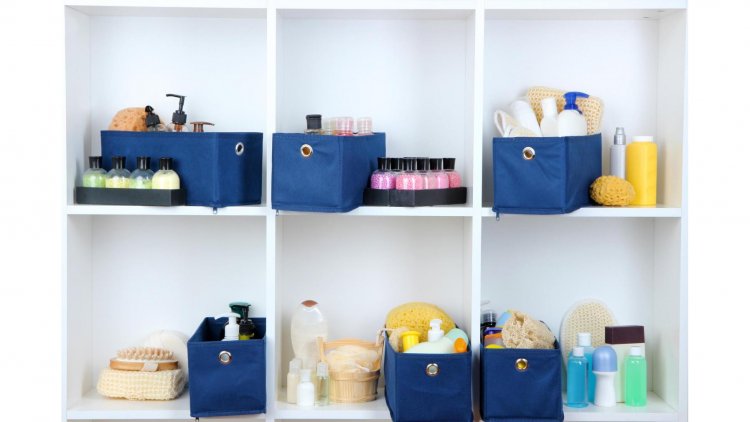Preserving Perfection: The Ultimate Guide to Storing Your Skincare Products for Maximum Longevity
Proper storage of skincare products is crucial for maintaining their efficacy and ensuring that they deliver the best results. With the right techniques, you can extend the lifespan of your favorite serums, creams, and treatments. Let’s delve into the essential strategies for safeguarding your skincare investments.

The Science of Skincare Storage
Understanding the science behind skincare storage is key to keeping your products effective. Most skincare products are formulated with active ingredients that can degrade over time if not stored properly. Temperature, light, and air exposure can all impact the stability of these ingredients.
Temperature: High temperatures can cause the breakdown of active ingredients, such as vitamins and antioxidants. For instance, retinol and vitamin C are particularly sensitive to heat, which can reduce their potency. Conversely, very low temperatures can also affect the consistency and efficacy of products. Therefore, it's crucial to store your products in a stable, moderate environment.
Light: UV rays can break down ingredients and lead to oxidative damage. Many skincare products are housed in opaque or dark-colored containers to minimize light exposure. However, even these should be stored away from direct sunlight.
Air Exposure: Exposure to air can cause oxidation, leading to changes in the color, texture, and effectiveness of products. Products that come in jars are particularly susceptible to air exposure each time the container is opened. Pump bottles, on the other hand, help minimize air exposure.
Ideal Storage Conditions
To keep your skincare products at their best, follow these storage guidelines:
1. Cool and Dry Places
Store your skincare products in a cool, dry place. The bathroom may seem like a convenient location, but its high humidity and fluctuating temperatures can compromise the integrity of your products. Instead, consider keeping your products in a bedroom drawer or a dedicated skincare cabinet where temperature and humidity levels are more consistent.
2. Avoid Direct Sunlight
Keep your products away from direct sunlight. Ultraviolet rays can break down ingredients and reduce the effectiveness of your skincare. A dark cupboard or drawer is ideal for most products. If you’re using products with high concentrations of active ingredients, consider placing them in a dedicated drawer or box that shields them from light exposure.
3. Refrigeration for Specific Products
Certain skincare products benefit from refrigeration. Products like eye creams, gels, and masks can be stored in the fridge to prolong their shelf life and enhance their cooling effects. However, be cautious with products containing emulsifiers or preservatives, as extreme cold can sometimes alter their texture or effectiveness.
4. Secure Packaging
Packaging plays a significant role in the preservation of skincare products. Always ensure that the lids are tightly closed to prevent air from entering. For products in jars, use a clean spatula to avoid contamination from your fingers. Pump dispensers are ideal as they minimize air exposure with each use.
Handling Product Expiration
Like any other consumable product, skincare items have expiration dates. Knowing how to handle and interpret these dates is crucial for maintaining your skin’s health.
1. Check Expiration Dates
Always check the expiration dates on your skincare products. Using expired products can lead to skin irritation or infection. Most products will have a “use by” or “expiration” date printed on the packaging. Pay attention to this date and replace products as needed.
2. Monitor Changes in Appearance
Even if a product is within its expiration date, monitor changes in its appearance, smell, or texture. Changes such as separation, discoloration, or an off-putting odor can indicate that the product has gone bad. If you notice any of these signs, it’s best to discard the product.
3. The PAO (Period After Opening)
Many products come with a Period After Opening (PAO) symbol, which looks like an open jar with a number inside. This symbol indicates how long the product is good for after it’s been opened. For instance, a symbol with “6M” means the product should be used within 6 months of opening.
Special Considerations for Natural and Organic Products
Natural and organic skincare products often contain fewer preservatives and can have shorter shelf lives compared to conventional products. Proper storage is even more critical for these products to prevent spoilage.
1. Limited Shelf Life
Natural products often lack synthetic preservatives, which means they can spoil more quickly. Always check the expiry dates and try to use natural products within a reasonable timeframe. Store them in cool, dry places, and consider refrigerating them if the product’s ingredients are particularly sensitive.
2. Avoid Cross-Contamination
With natural products, avoiding cross-contamination is crucial. Use clean utensils to dispense products from jars and always wash your hands before applying creams or serums. Contaminants can lead to faster spoilage and reduce the efficacy of your products.
Tips for Traveling with Skincare Products
Traveling with skincare products requires some extra consideration to ensure they remain in good condition. Here’s how to manage your skincare while on the go.
1. Use Travel-Sized Containers
Transfer your products into travel-sized containers to save space and reduce the risk of leakage. Ensure these containers are properly sealed and labeled. It’s also a good idea to keep these containers in a resealable plastic bag to prevent any mess in your luggage.
2. Temperature Control
If you’re traveling to a destination with extreme temperatures, be mindful of how your skincare products are affected. In hot climates, products may need to be kept in an insulated bag, while in cold climates, consider carrying them in an inner pocket to avoid freezing.
3. Keep Products in Their Original Packaging
Whenever possible, keep products in their original packaging to avoid confusion and potential mishandling. If original packaging isn’t feasible, ensure that any alternative containers are clean and properly labeled.
Understanding Expiration Dates and Indicators
Knowing how to read and interpret expiration dates and other indicators on your skincare products is essential for ensuring their safety and efficacy.
1. Expiration Dates
Expiration dates are the most straightforward indicator of a product’s shelf life. These dates are often printed directly on the product’s packaging. Use products before these dates to ensure optimal performance and avoid potential skin issues.
2. PAO Symbols
The PAO symbol provides guidance on how long a product is safe to use after opening. Familiarize yourself with this symbol and adhere to the recommended timeframe for using the product. For products without a PAO symbol, a general rule is to use them within 6 to 12 months after opening.
3. Batch Codes
Batch codes can be used to determine a product’s manufacturing date. If you’re unsure about the freshness of a product, you can use the batch code to contact the manufacturer and get more detailed information about the product’s age.
Effective Storage Solutions
Investing in the right storage solutions can significantly enhance the longevity of your skincare products. Here are some practical storage solutions to consider:
1. Skincare Fridge
A skincare fridge is a specialized mini-fridge designed to keep your skincare products at optimal temperatures. These fridges help prolong the life of certain products, especially those sensitive to heat. They also provide a luxurious cooling effect for products like eye creams and face masks.
2. Cosmetic Organizers
Invest in cosmetic organizers to keep your products neat and accessible. Organizers with compartments can help prevent cross-contamination and ensure that products are stored upright, reducing the risk of spills and leaks.
3. Air-Tight Containers
For products that need extra protection, consider transferring them into air-tight containers. These containers can help minimize exposure to air and moisture, further preserving the efficacy of your products.
How to Store Different Types of Skincare Products
Different types of skincare products have unique storage requirements. Understanding these can help you maintain their effectiveness and extend their shelf life.
1. Serums and Treatments
Serums often contain high concentrations of active ingredients like vitamin C, retinol, or hyaluronic acid, making them more susceptible to degradation. Store them in a cool, dark place, ideally in their original packaging to protect them from light and air.
Treatments such as acne medications or anti-aging products may require more specific conditions. For instance, products containing benzoyl peroxide or salicylic acid should be kept away from heat and light to prevent them from breaking down.
2. Moisturizers and Creams
Moisturizers and creams are generally more stable but still require proper storage to ensure their longevity. Store these products in a cool, dry place, and avoid keeping them in the bathroom due to fluctuating humidity. For those in jars, use a clean spatula to scoop out the product to avoid contamination.
3. Sunscreens
Sunscreens are crucial for protecting your skin from UV damage, so their efficacy must be preserved. Store them in a cool, dark place away from direct sunlight. Sunscreens can degrade quickly if exposed to heat, so avoid leaving them in a hot car or near a window.
4. Face Masks
Face masks, whether they’re clay-based, sheet masks, or gel masks, also benefit from cool storage. For masks that come in jars, ensure the lid is tightly closed and avoid frequent opening. Refrigerating masks can enhance their cooling effect and prolong their shelf life.
5. Eye Creams
Eye creams can benefit from being kept in the refrigerator. The cooling effect can help reduce puffiness and make the cream feel more refreshing. However, avoid extreme temperatures and ensure that the container is airtight to prevent contamination.
DIY Skincare Storage Hacks
If you’re into DIY skincare, you might want to know how to store homemade products properly. DIY skincare often lacks preservatives and can spoil faster than commercial products. Here are some tips for keeping your DIY creations fresh:
1. Use Preservatives Wisely
Consider adding natural preservatives such as Vitamin E oil or grapefruit seed extract to your DIY formulations. These can help extend the shelf life of your products, though they won’t make them last indefinitely.
2. Refrigerate Homemade Products
Refrigeration is often the best way to extend the shelf life of homemade skincare products. Store them in airtight containers to prevent contamination and spoilage. Label your containers with the date they were made and use them within a short timeframe.
3. Clean Containers
Always use clean, sterilized containers for your DIY products. This helps minimize the risk of introducing bacteria or mold. Sterilize containers by boiling them or washing them thoroughly with hot, soapy water.
Troubleshooting Common Storage Issues
Even with the best storage practices, issues can still arise. Here’s how to troubleshoot common storage problems with your skincare products:
1. Product Separation
If you notice that a product has separated into layers, it may be a sign of improper storage or degradation. Try shaking the product to mix it back together. If it doesn’t blend back into a consistent texture or if it has an off smell, it may be time to discard it.
2. Change in Texture or Smell
A change in texture or smell can indicate that a product has gone bad. Creams that become too runny, or serums that smell rancid, should be discarded. Proper storage should minimize these issues, but always monitor your products for any changes.
3. Mold or Discoloration
Mold or discoloration is a serious issue and usually indicates that a product has been contaminated or is past its prime. If you see mold or notice any unusual color changes, it’s best to discard the product immediately to avoid skin irritation or infections.
Maintaining Skincare Product Hygiene
Keeping your skincare products hygienic is vital for maintaining their effectiveness and preventing contamination. Here’s how to ensure your products remain clean:
1. Wash Your Hands
Before applying or dispensing any skincare products, always wash your hands thoroughly. This helps prevent the transfer of dirt, oils, and bacteria to the product.
2. Use Clean Utensils
For products in jars or tubs, use clean spatulas or spoons to remove the product instead of your fingers. This helps prevent introducing bacteria into the product and keeps it fresher for longer.
3. Avoid Sharing Products
Avoid sharing your skincare products with others, as this can lead to contamination. Each person’s skin has different bacteria and oils that could potentially introduce pathogens into the product.
Staying Informed About Product Innovations
Keeping up with new developments in skincare technology can help you stay informed about the best practices for storing and using your products. Manufacturers often introduce new packaging solutions or preservatives that can enhance product longevity.
1. Keep Up with Packaging Innovations
Many brands are investing in advanced packaging technologies to extend the shelf life of their products. For instance, airless pumps and opaque containers are becoming more common, which help reduce exposure to air and light.
2. Stay Updated on Ingredients
Stay informed about the latest research on skincare ingredients. New findings can impact how products should be stored and used. For example, recent studies may reveal new sensitivities or storage requirements for popular ingredients like peptides or hyaluronic acid.
Proper storage of your skincare products is essential for maintaining their effectiveness and ensuring that you get the most out of your skincare routine. By understanding the factors that affect product longevity and implementing effective storage solutions, you can keep your skincare products fresh and functional for a longer period. Whether it’s by choosing the right storage location, using suitable containers, or staying informed about product innovations, your commitment to proper skincare storage will pay off in the health and appearance of your skin.
Disclaimer: The content shared on this blog is intended for informational purposes only. Consulting a professional about the highlighted information is recommended. The blog and its authors are not liable for any adverse effects or consequences resulting from the use of the methods or products provided. Always prioritize your health and safety.
What's Your Reaction?





















